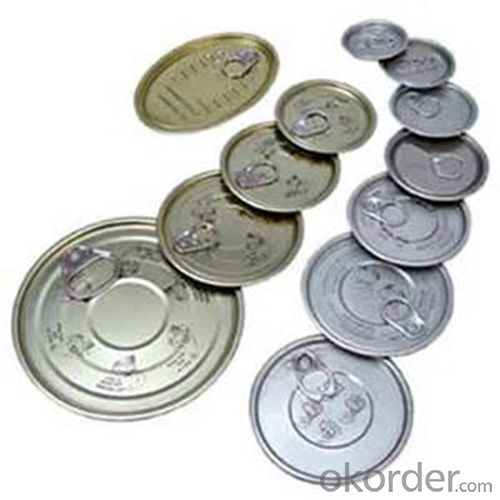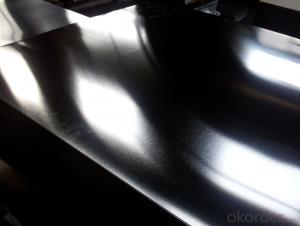Prime Quality Tinplate and Tin Free Steel
- Loading Port:
- Shanghai
- Payment Terms:
- TT OR LC
- Min Order Qty:
- 25 m.t.
- Supply Capability:
- 25000 m.t./month
OKorder Service Pledge
OKorder Financial Service
You Might Also Like
Item specifice
1.Structure of Prime Quality Tinplate and Tin Free Steel Description
Tin Free Steel (TFS) is thin black plate with two coats; one of metal chrome film and the other of chromium oxide. TFS is ideal for the manufacturing of crowns, container ends & shallow drawn cans etc. TFS is also known as Chromium coated steel.
2.Main Features of the Prime Quality Tinplate and Tin Free Steel
Chromium coated
Corrosion Resistant
Easier to recycle.
Sulphur Blackening Resistance: TFS has sulphur resistance properties, which can be used for canning protein- rich food such as fish.
Filiform Rust Resistance: Filiform is superficial corrosion of the base metal. TFS has a superior base metal which makes it corrosion resistance.
TFS should be Lacquered / Coated to prevent rust in humid condition.
Internal Coating / Lacquering can be avoided in the case of TFS used to store motor oil or cooking oil.
3.Prime Quality Tinplate and Tin Free Steel Images


4.Prime Quality Tinplate and Tin Free Steel Specification
Standard: ISO 11949 -1995, GB/T2520-2000,JIS G3303,ASTM A623, BS EN 10202
Material: MR,SPCC
Thickness:0.15mm - 0.50mm
Width: 600mm -1150mm
Temper: T1-T5
Annealing: BA & CA
Coil Inner Diameter: 508mm
Weight: 6-10 tons/coil 1~1.7 tons/sheets bundle
Passivation:311
Oil: DOS
Surface: Finish,bright,stone,matte,silver
5.FAQ of Prime Quality Tinplate and Tin Free Steel
-What is MOQ?
Our MOQ would be 25 tons.
- Do you only have prime quality?
We can supply both prime and second quality.
- Q:How is tinplate formed into different shapes?
- Tinplate is formed into different shapes through a process called metal stamping or deep drawing. The tinplate sheet is fed into a machine where a die and punch press it into the desired shape. The pressure exerted by the punch forces the tinplate to conform to the shape of the die, resulting in the formation of various shapes such as cans, containers, or lids.
- Q:Can tinplate be welded or soldered?
- Yes, tinplate can be both welded and soldered. Welding involves fusing two pieces of metal together using heat, while soldering involves joining metal components using a lower melting point filler material called solder. Tinplate, which is a thin sheet of steel coated with a layer of tin, can undergo these processes with appropriate techniques and materials.
- Q:Can tinplate be used for non-packaging applications?
- Yes, tinplate can be used for non-packaging applications. Tinplate's corrosion resistance, durability, and versatility make it suitable for various non-packaging uses such as construction materials, automotive parts, electrical equipment, and decorative items.
- Q:What are the different methods of reusing tinplate packaging?
- There are several ways to reuse tinplate packaging. One common method is to repurpose the packaging for storing small items like buttons, jewelry, or crafting supplies. Tinplate packaging can also be used as decorative containers for plants, candles, or as unique gift boxes. Additionally, tinplate packaging can be recycled and used to create new products, reducing waste and promoting sustainability.
- Q:What is the shelf life of products packaged in tinplate?
- The shelf life of products packaged in tinplate can vary depending on the specific product and its storage conditions. However, tinplate is known for its excellent protection against moisture, light, and oxygen, which helps to extend the shelf life of packaged goods. Generally, products packaged in tinplate can have a shelf life ranging from several months to years, ensuring product freshness and quality for an extended period.
- Q:How does tinplate contribute to the efficiency of energy systems?
- Tinplate contributes to the efficiency of energy systems by providing a lightweight, durable, and corrosion-resistant material for packaging and storage of energy products. It helps in reducing energy loss during transportation and prolongs the shelf life of energy products, ensuring maximum utilization and minimizing waste. Additionally, tinplate can be easily recycled, reducing the energy required for manufacturing and promoting a sustainable energy system.
- Q:Tinplate which applies to product packaging?
- Tinplate has obvious superiority compared with other packaging materials.1. good mechanical properties: tinplate cans relative to other containers, such as plastic, glass, paper containers and uniform strength and good rigidity, it is not easy to break. It is not only used for small sale packing, but also the main container for large transportation package.
- Q:What are the main challenges in tinplate welding and soldering?
- The main challenges in tinplate welding and soldering include achieving proper adhesion due to the thinness of the tin coating, ensuring the cleanliness of the surface to prevent contamination, and controlling the heat input to avoid warping or damaging the tinplate material. Additionally, the low melting point of tin can make it prone to overheating or burning, requiring careful temperature control during the welding or soldering process.
- Q:What are the advantages of using tinplate for paint cans?
- There are several advantages of using tinplate for paint cans. Firstly, tinplate is highly durable and provides excellent protection against corrosion, ensuring the longevity of the paint. Secondly, tinplate is lightweight, making it easier to handle and transport the cans. Additionally, tinplate is non-reactive, meaning it won't interact with the paint, preserving its quality and preventing any chemical reactions. Lastly, tinplate is a sustainable and recyclable material, making it an environmentally friendly choice for packaging paint.
- Q:How does tinplate compare to aluminum packaging in terms of cost?
- In terms of cost, tinplate tends to be more affordable compared to aluminum packaging.
1. Manufacturer Overview |
|
|---|---|
| Location | |
| Year Established | |
| Annual Output Value | |
| Main Markets | |
| Company Certifications | |
2. Manufacturer Certificates |
|
|---|---|
| a) Certification Name | |
| Range | |
| Reference | |
| Validity Period | |
3. Manufacturer Capability |
|
|---|---|
| a)Trade Capacity | |
| Nearest Port | |
| Export Percentage | |
| No.of Employees in Trade Department | |
| Language Spoken: | |
| b)Factory Information | |
| Factory Size: | |
| No. of Production Lines | |
| Contract Manufacturing | |
| Product Price Range | |
Send your message to us
Prime Quality Tinplate and Tin Free Steel
- Loading Port:
- Shanghai
- Payment Terms:
- TT OR LC
- Min Order Qty:
- 25 m.t.
- Supply Capability:
- 25000 m.t./month
OKorder Service Pledge
OKorder Financial Service
Similar products
New products
Hot products
Related keywords



























